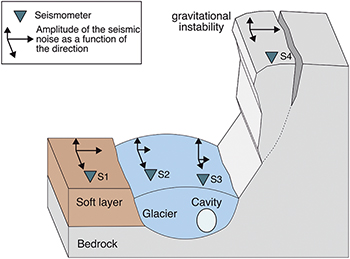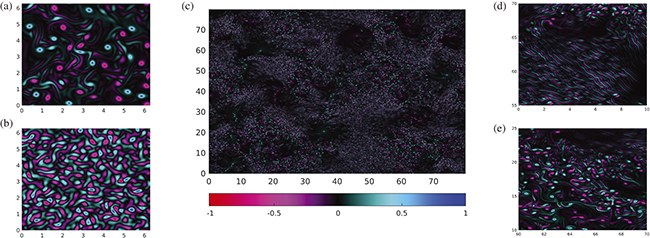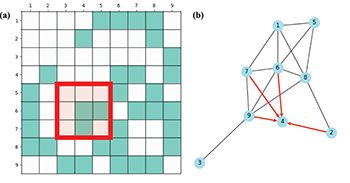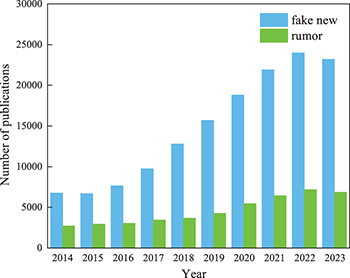J. Starke, I. Wienk, R. Rousseau, N. Bontemps, L. Moreau and E. Larose
Published 12 May 2025
Citation J. Starke et al 2025 EPL 150 30001

Ambient seismic noise consists of continuous vibrations randomly excited in time and space, mostly at the Earth’s surface, by natural and anthropogenic dynamic phenomena. Noise has long been considered a contaminant of seismic impulse responses from earthquakes or man-made explosions. The deterministic nature of the wave equation, together with the temporal and spatial coherence of seismic waves and the development of massive computing infrastructures, have enabled our ability to turn “noise into signal” and to obtain deterministic images of the Earth’s subsurface and its mechanical evolution from these random-like noise records.
Jing Guan and Kezan Li
Published 30 April 2025
Citation Jing Guan and Kezan Li 2025 EPL 150 31001

Synchronization plays a crucial role in complex dynamical networks, ensuring coordinated behaviors among interconnected nodes. Successive lag synchronization (SLS) is a distinctive synchronization type characterized by sequential synchronization between adjacent nodes with a fixed time delay. SLS specifically addresses scenarios with precisely structured and ordered interactions, presenting potential applications such as drone formations during military parades, autonomous vehicle platooning, and sequential industrial processes. Despite its theoretical and practical significance, systematic exploration of SLS remains limited, primarily due to challenges in ensuring stability across diverse dynamical networks and handling complex time delay disturbances. This Perspective provides a brief review of SLS, clearly defining its unique features, systematically analyzing stability considerations and implementation methods across various dynamical networks using both continuous and discontinuous controllers. Additionally, specific algorithms and control-free strategies for achieving SLS are discussed. Finally, this Perspective highlights key open issues and suggests promising future research directions.
Rahul Pandit and Kolluru Venkata Kiran
Published 11 April 2025
Citation Rahul Pandit and Kolluru Venkata Kiran 2025 EPL 150 13001

We provide an overview of theoretical developments in the rapidly developing field of active-fluid turbulence. After a summary of the partial differential equations (PDEs) for active fluids with scalar, polar, and nematic order parameters, we concentrate on a minimal description that employs the Toner-Tu-Swift-Hohenberg (TTSH) model. We present illustrative results —numerical, theoretical, and rigorous— for TTSH turbulence. In particular, we present statistical properties of such turbulence in both Eulerian and Lagrangian frameworks. We end with a perspective of new trends in the field of active-fluid turbulence.
Jia Li, Yixiu Ji, Yu Zhang, Jie Ding, Cong Li and Xiang Li
Published 25 April 2025
Citation Jia Li et al 2025 EPL 150 21001

Graph Neural Networks (GNNs), a class of neural networks specifically designed to handle graph-structured data, have emerged as a hot research topic in fields such as data mining, machine learning, and biomedical engineering. Network science studies the properties and behaviors of complex networks, with graphs serving as the mathematical abstraction of these systems. In recent years, GNN technology has demonstrated significant application potential in network science. In this letter, we provide a mini review of different types of GNNs, as well as their applications in important network science tasks, particularly in nodes and edges identification as well as network robustness. Finally, we discuss the promising future research directions.
Hao Liao, Jiwei Zhang, Wei Zhang, Zhen-Zhen Wang, Mingyang Zhou, Xiaoqun Wu and Naipeng Chao
Published Published 10 April 2025
Citation Hao Liao et al 2025 EPL 150 11001

Social media platforms, as complex socio-technical ecosystems, have reshaped the way individuals access, share, and interpret information. The interplay of diverse users, rapid content flow, and intricate network structures exemplifies the complexity science domain, where dynamic interactions give rise to emergent patterns of influence and opinion formation. In this perspective, we review three key areas of intelligent information dissemination on social media: 1) rumor and fake news detection, 2) competitive dissemination, and 3) the identification of influential nodes. We highlight recent advancements that leverage complexity-aware models, graph-based algorithms, and deep learning techniques to manage content credibility and guide the spread of verified information. Finally, we propose future research directions that bridge theory and practice, ultimately contributing to a more informed, reliable, and adaptive digital information ecosystem.
Title |
Authors |
| Orbitronics: Orbital currents in solids | Go, Dongwook; Jo, Daegeun; Lee, Hyun-Woo; Klaeui, Mathias; Mokrousov, Yuriy |
| Quantum computing models for artificial neural networks | Mangini, S.; Tacchino, F.; Gerace, D.; Bajoni, D.; Macchiavello, C. |
| Running vacuum against the H0 and σ8 tensions | Peracaula, Joan Sola; Gomez-Valent, Adria; de Cruz Perez, Javier; Moreno-Pulido, Cristian |
| Collision models in open system dynamics: A versatile tool for deeper insights? | Campbell, Steve; Vacchini, Bassano |
| Active engines: Thermodynamics moves forward | Fodor, Etienne; Cates, Michael E. |
| Long-ranged velocity correlations in dense systems of self-propelled particles | Szamel, Grzegorz; Flenner, Elijah |
| Chiral active matter | Liebchen, Benno; Levis, Demian |
| Partial synchronization patterns in brain networks | Schoell, Eckehard |
| 20 years of ordinal patterns: Perspectives and challenges | Leyva, Inmaculada; Martinez, Johann H.; Masoller, Cristina; Rosso, Osvaldo A.; Zanin, Massimiliano |
| An overview of generalized entropic forms | Ilic, V. M.; Korbel, J.; Gupta, S.; Scarfone, A. M. |
The physics of seismic noise: A revolution in Earth imaging and monitoring By J. Starke, I. Wienk, R. Rousseau, N. Bontemps, L. Moreau and E. Larose
Successive lag synchronization on dynamical networks: A perspective By Jing Guan and Kezan Li
Particles and fields in minimal hydrodynamic models for active turbulence By Rahul Pandit and Kolluru Venkata Kiran
Graph neural networks for network science: A mini review By Jia Li, Yixiu Ji, Yu Zhang, Jie Ding, Cong Li and Xiang Li
Dissemination intelligence information on social media By Hao Liao, Jiwei Zhang, Wei Zhang, Zhen-Zhen Wang, Mingyang Zhou, Xiaoqun Wu and Naipeng Chao
Experimental realizations of information engines: Beyond proof of concept By Rémi Goerlich, Laura Hoek, Omer Chor, Saar Rahav and Yael Roichman
Ten years of the digital twin brain: Perspectives and challenges By Shuqi Guo, Ge Zhang, Xin Zeng, Yue Xiong, Yuanhang Xu, Yan Cui, Dezhong Yao and Daqing Guo
Attosecond microscopy —Advances and outlook By J. Vogelsang, A. Mikkelsen, C. Ropers, J. H. Gaida, M. Garg, K. Kern, J. Miao, M. Schultze and M. Ossiander
Harnessing individual nitrogen-vacancy centers with a compact and portable confocal microscope By I. Panadero, J. C. Guerra, E. Caravaca, F. J. Hidalgo, P. Acedo, C. de Dios and E. Torrontegui
Toward robust network controllability: Insights and future directions By Yang Lou, Lin Wang and Guanrong Chen
Perspectives on modelling epidemics with human mobility By Xin Lu, Jiawei Feng and Suoyi Tan
Reputation mechanisms and cooperative emergence in complex network games: Current status and prospects By Wei Tang, Hui Yang and Chun Wang
Global non-equilibrium thermodynamics for steady states like never before By R. Holyst, K. Giżyński, A. Maciołek, K. Makuch, J. Wróbel and P. J. Żuk
Evolutionary dynamics with random payoff matrices By Manh Hong Duong and The Anh Han
The absolute swampland By Astrid Eichhorn, Arthur Hebecker, Jan M. Pawlowski and Johannes Walcher
Scaling laws of urban heavy truck mobility By Xiao-Zhe Pang, Xu-Jie Lin, Yitao Yang, Erjian Liu, Xiang-Yu Jia, Ying-Yue Lv, Zile Guo, Yang Wang and Xiao-Yong Yan
A brief review on evolutionary game models for the emergence of fairness By Yanling Zhang, Yin Li and Feng Xiao
Correlated catalyst in quantum thermodynamics By Naoto Shiraishi
The unbearable lightness of restricted Boltzmann machines: Theoretical insights and biological applications By Giovanni di Sarra, Barbara Bravi and Yasser Roudi
Macroscopic arrow of time from multiscale perspectives By Mahendra K. Verma
CompLex: Legal systems through the lens of complexity science By Pierpaolo Vivo, Daniel M. Katz and J. B. Ruhl
Mobility-induced kinetic effects in multicomponent mixtures. By F. C. Thewes, M. Krüger and P. Sollich
Temporal coherences of atomic chaotic light sources: The Siegert relation and its generalisation to higher-order correlation functions. By M. Morisse, S. Joshi, J. Mika, J. C. C. Capella, R. Kaiser, R. Bachelard, L. Slodička and M. Hugbart
Dynamics of diseases spreading on networks in the forms of reaction-diffusion systems. By Gui-Quan Sun, Runzi He, Li-Feng Hou, Shupeng Gao, Xiaofeng Luo, Quanhui Liu, Yicheng Zhang and Lili Chang
Message-passing approach for percolation on the networked system: A mini-review. By Cheng Qian, Dan-Dan Zhao, Ming Zhong, Bo Zhang, Hao Peng and Wei Wang
Perspective on physical interpretations of Rényi entropy in statistical mechanics. By Misaki Ozawa and Nina Javerzat
Complex phases in quantum mechanics. By Carl M. Bender and Daniel W. Hook
Information scrambling —A quantum thermodynamic perspective. By Akram Touil and Sebastian Deffner
Tuning of magnetic bistability and domain wall dynamics in magnetic microwires. By Arcady Zhukov, Paula Corte-Leon, Ahmed Talaat, Juan Maria Blanco, Alvaro Gonzalez, Alfonso García-Gomez and Valentina Zhukova
Ultracold atomic spin mixtures in ultrastable magnetic field environments. By Riccardo Cominotti, Chiara Rogora, Alessandro Zenesini, Giacomo Lamporesi and Gabriele Ferrari
Evolutionary dynamic of division of labor games. By Chunyan Zhang and Ziheng Wang
Interplay of synchronization and cortical input in models of brain networks. By Jakub Sawicki and Eckehard Schöll
Multifactorial effects on bounded rational decision-making. By Dun Han and Xiang Li
Advanced progress of network resilience. By Min Liu, Qiang Guo and Jianguo Liu
Atomic topological quantum matter using synthetic dimensions. By A. Fabre and S. Nascimbene
Synchronization on higher-order networks. By Haoran Liu, Jin Zhou, Bo Li, Meng Huang, Jun-an Lu and Dinghua Shi
Interfacial instabilities in confined displacements involving non-Newtonian fluids. By Vaibhav Raj Singh Parmar and Ranjini Bandyopadhyay
Accelerations of large inertial particles in turbulence. By Yaning Fan, Cheng Wang, Linfeng Jiang, Chao Sun and Enrico Calzavarini
Ultracold atoms carrying orbital angular momentum: Engineering topological phases in lattices. By E. Nicolau, G. Pelegrí, J. Polo, A. M. Marques, A. J. Daley, J. Mompart, R. G. Dias and V. Ahufinger
Dynamic modeling of neuromodulation techniques: Towards elaboration and individual specificity. By Ying Yu, Fang Han and Qingyun Wang
Elasticity, plasticity and screening in amorphous solids: A short review. By Avanish Kumar and Itamar Procaccia
Quantum control by effective counterdiabatic driving. By Francesco Petiziol, Florian Mintert and Sandro Wimberger
Augmented dynamics of nonlinear systems: A review. By Nirmal Punetha, Anjuman Ara Khatun, Haider Hasan Jafri, Awadhesh Prasad and Manish Dev Shrimali
Cooperation dynamics in multiple correlated games: A review. By Ji Quan, Xiao Jian Ma, Shengjin Cui and Xianjia Wang
Coupled propagation dynamics on complex networks: A brief review. By Zhishuang Wang, Haoxian Li, Jiaxing Chen, Zhiyong Hong, Qian Yin and Chengyi Xia
European Physical Society
6, rue des Frères Lumière
68200 Mulhouse
France




Copyright© 2025 – EPL Association
Non-profit, community owned
Impact factor: 1.8
Submission to publication: 73 days
European Physical Society
6, rue des Frères Lumière
68200 Mulhouse
France




Copyright© 2025 – EPL Association